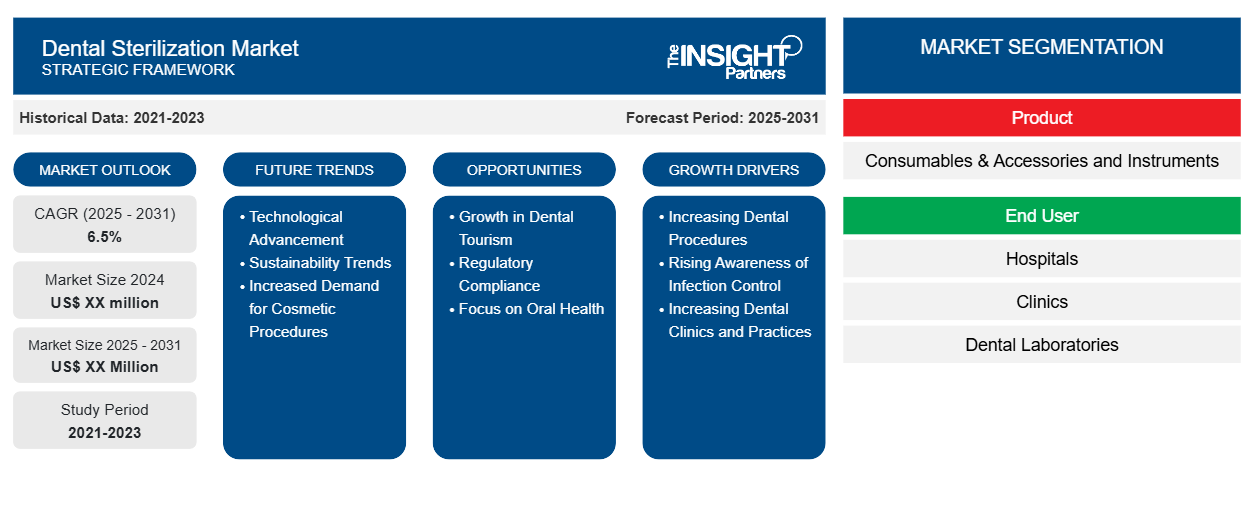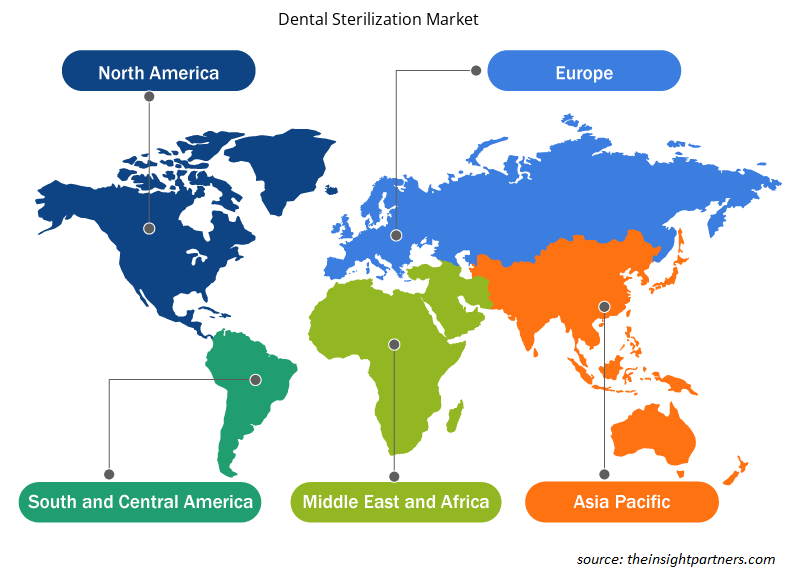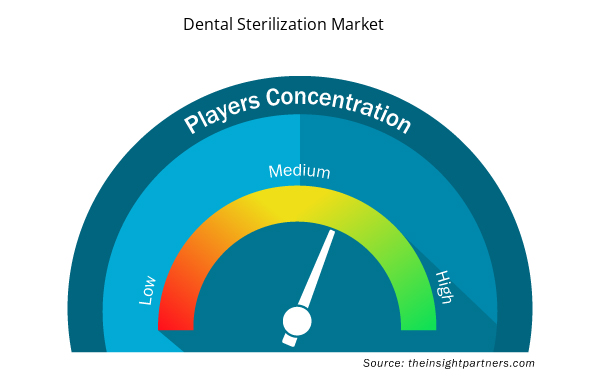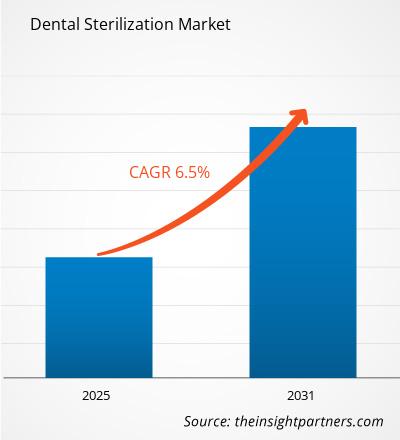Der Markt für zahnärztliche Sterilisation wird voraussichtlich von 2025 bis 2031 eine durchschnittliche jährliche Wachstumsrate (CAGR) von 6,5 % verzeichnen, wobei die Marktgröße von XX Millionen US-Dollar im Jahr 2024 auf XX Millionen US-Dollar im Jahr 2031 wachsen wird.
Der Bericht ist nach Produkt (Verbrauchsmaterialien, Zubehör und Instrumente) und Endverbraucher (Krankenhäuser, Kliniken und Dentallabore) segmentiert. Die globale Analyse ist weiter auf regionaler Ebene und nach wichtigen Ländern aufgeschlüsselt. Der Bericht bietet den Wert in USD für die oben genannte Analyse und Segmente.
Zweck des Berichts
Der Bericht Dental Sterilization Market von The Insight Partners zielt darauf ab, die aktuelle Situation und das zukünftige Wachstum sowie die wichtigsten treibenden Faktoren, Herausforderungen und Chancen zu beschreiben. Dies wird verschiedenen Geschäftspartnern Einblicke geben, wie zum Beispiel:
- Technologieanbieter/-hersteller: Um die sich entwickelnde Marktdynamik zu verstehen und die potenziellen Wachstumschancen zu kennen, damit sie fundierte strategische Entscheidungen treffen können.
- Investoren: Durchführung einer umfassenden Trendanalyse hinsichtlich der Marktwachstumsrate, der finanziellen Marktprognosen und der Chancen entlang der Wertschöpfungskette.
- Regulierungsbehörden: Sie regulieren Richtlinien und polizeiliche Aktivitäten auf dem Markt mit dem Ziel, Missbrauch zu minimieren, das Vertrauen der Anleger zu bewahren und die Integrität und Stabilität des Marktes aufrechtzuerhalten.
Dentalsterilisation Marktsegmentierung
Produkt
- Verbrauchsmaterialien & Zubehör und Instrumente
Endbenutzer
- Krankenhäuser
- Kliniken
- Zahntechnische Labore
Passen Sie diesen Bericht Ihren Anforderungen an
Sie erhalten kostenlos individuelle Anpassungen an jedem Bericht, einschließlich Teilen dieses Berichts oder einer Analyse auf Länderebene, eines Excel-Datenpakets sowie tolle Angebote und Rabatte für Start-ups und Universitäten.
Markt für zahnärztliche Sterilisation: Strategische Einblicke

- Holen Sie sich die wichtigsten Markttrends aus diesem Bericht.Dieses KOSTENLOSE Beispiel umfasst eine Datenanalyse von Markttrends bis hin zu Schätzungen und Prognosen.
Wachstumstreiber auf dem Markt für zahnärztliche Sterilisation
- Zunahme zahnärztlicher Eingriffe: Im Dentalsektor gibt es einen starken Anstieg zahnärztlicher Eingriffe, und der Fortschritt in der Dentaltechnologie führt zu einer höheren Nachfrage nach Sterilisationsgeräten und -produkten, da Gesundheitseinrichtungen die Patientensicherheit gewährleisten möchten. Ein Anstieg im Dentalsektor aufgrund der zunehmenden Zahl durchgeführter Eingriffe, insbesondere minimalinvasiver Eingriffe, hat zu höheren Anforderungen an strenge Infektionsschutzmaßnahmen geführt. Höhere Eingriffsvolumina erfordern stärkere Sterilisationsprozesse.
- Steigendes Bewusstsein für Infektionskontrolle: Das wachsende Bewusstsein für Infektionskontrolle bei Zahnärzten und Patienten hinsichtlich der Wichtigkeit der Verhinderung von Kreuzkontaminationen und Infektionen hat die Nachfrage nach effektiveren Sterilisationsmethoden und -produkten angeheizt. In Verbindung mit der wachsenden Bedeutung der Patientensicherheit während der Zahnarztpraxis entsteht dadurch ein Umfeld, das die Aufmerksamkeit auf Infektionskontrollmaßnahmen lenkt. Patienten werden sich der möglichen infektionsbedingten Risiken bewusst und fordern daher effektive Sterilisationspraktiken während der Zahnbehandlung.
- Zunehmende Zahl von Zahnkliniken und -praxen: Der Boom bei Zahnkliniken und -praxen, insbesondere in städtischen Gebieten, führt zu einem steigenden Bedarf an wirksamen Sterilisationsprodukten und -dienstleistungen zur Erreichung guter Hygienestandards. Mit dem gestiegenen Bewusstsein für Infektionskontrollpraktiken im Gesundheitssektor im Allgemeinen ist ein wachsender Bedarf an diesem Service entstanden. Infolgedessen hat die aktuelle Situation dazu geführt, dass Zahnkliniken mehr Wert darauf legen, absolute Sterilisationsprotokolle anzuwenden, um maximale Sicherheit zu gewährleisten und das Vertrauen der Patienten zu gewinnen.
Zukünftige Trends auf dem Markt für zahnärztliche Sterilisation
- Technologischer Fortschritt: Die Sterilisation wird durch leistungsstarke Autoklaven, chemische Sterilisationsmittel und Methoden der Schnellsterilisation immer effizienter. Da der Einsatz moderner zahnmedizinischer Technologien und Verfahren manchmal komplexe Sterilisationsanwendungen erfordert, erfordern neue Instrumente und Geräte eine effektive Sterilisation, wodurch Kreuzkontaminationen zum Wohle der Patienten vermieden werden.
- Nachhaltigkeitstrends: Nachhaltigkeitsthemen rücken in der Dentalbranche zunehmend in den Fokus. Umweltfreundliche Sterilisationsverfahren und -produkte werden immer mehr zum Mainstream. So werden beispielsweise biologisch abbaubare Verpackungen und weniger giftige Sterilisationschemikalien eingeführt. Immer mehr Hersteller produzieren energiesparende Sterilisationsgeräte – beispielsweise Dampfsterilisatoren, die weniger Wasser und Strom verbrauchen.
- Erhöhte Nachfrage nach kosmetischen Eingriffen: Viele Patienten wünschen sich ästhetische Zahnbehandlungen wie Bleaching, Veneers und kieferorthopädische Eingriffe. Daher erfordert die Qualität zahnärztlicher Leistungen eine Reihe strenger Sterilisationsprotokolle, um die Patienten vor Infektionsrisiken zu schützen.
Marktchancen für zahnärztliche Sterilisation
- Wachstum im Zahntourismus: Die Zahntourismusbranche, bei der Patienten für eine Zahnbehandlung in ein anderes Land reisen, fördert aus Qualitäts- und Sicherheitsgründen die Notwendigkeit standardisierter Sterilisationsprotokolle. In immer mehr Regionen wird von verstärkten Zahntourismusaktivitäten berichtet, und damit auch von der Entstehung neuer Zahnkliniken. Somit werden effektive Sterilisationslösungen in die Zahntourismusbranche eingeführt, die sich an unterschiedliche Patienten richtet.
- Einhaltung gesetzlicher Vorschriften: Die von Gesundheitsbehörden und Organisationen wie OSHA, CDC und WHO streng durchgesetzten Mindestanforderungen, wie etwa eine angemessene Infektionskontrolle und Sterilisationspraxis in Zahnkliniken, steigern die Nachfrage nach Sterilisationsgeräten und -lösungen. Die Einhaltung gesetzlicher Vorschriften stellt sicher, dass die Patientenversorgung den höchsten Standards der Infektionskontrolle entspricht und den gesetzlichen Bestimmungen entspricht.
- Fokus auf Mundgesundheit: Der verstärkte Fokus auf Mundhygiene aufgrund der wachsenden Kampagnen und Initiativen auf der ganzen Welt ermutigt auch mehr Zahnärzte, sich für Sterilisationen zu entscheiden. Aufklärungsinitiativen, die auf die Bedeutung der Mundgesundheit abzielen, haben das Bewusstsein der Menschen geschärft und führen daher zu mehr Besuchen in Zahnkliniken.
Regionale Einblicke in den Markt für Zahnsterilisation
Die regionalen Trends und Faktoren, die den Markt für Dentalsterilisation im Prognosezeitraum beeinflussen, wurden von den Analysten von Insight Partners ausführlich erläutert. In diesem Abschnitt werden auch die Marktsegmente und die Geografie für Dentalsterilisation in Nordamerika, Europa, im asiatisch-pazifischen Raum, im Nahen Osten und Afrika sowie in Süd- und Mittelamerika erörtert.

- Erhalten Sie regionale Daten zum Markt für zahnärztliche Sterilisation
Marktbericht zur zahnärztlichen Sterilisation – Umfang
| Berichtsattribut | Details |
|---|---|
| Marktgröße im Jahr 2024 | XX Millionen US-Dollar |
| Marktgröße bis 2031 | XX Millionen US-Dollar |
| Globale CAGR (2025 - 2031) | 6,5 % |
| Historische Daten | 2021-2023 |
| Prognosezeitraum | 2025–2031 |
| Abgedeckte Segmente | Nach Produkt
|
| Abgedeckte Regionen und Länder | Nordamerika
|
| Marktführer und wichtige Unternehmensprofile |
|
Marktteilnehmerdichte für zahnärztliche Sterilisation: Auswirkungen auf die Geschäftsdynamik verstehen
Der Markt für Dentalsterilisation wächst rasant, angetrieben durch die steigende Nachfrage der Endnutzer aufgrund von Faktoren wie sich entwickelnden Verbraucherpräferenzen, technologischen Fortschritten und einem größeren Bewusstsein für die Vorteile des Produkts. Mit steigender Nachfrage erweitern Unternehmen ihr Angebot, entwickeln Innovationen, um die Bedürfnisse der Verbraucher zu erfüllen, und nutzen neue Trends, was das Marktwachstum weiter ankurbelt.
Die Marktteilnehmerdichte bezieht sich auf die Verteilung der Firmen oder Unternehmen, die in einem bestimmten Markt oder einer bestimmten Branche tätig sind. Sie gibt an, wie viele Wettbewerber (Marktteilnehmer) in einem bestimmten Marktraum im Verhältnis zu seiner Größe oder seinem gesamten Marktwert präsent sind.
Die wichtigsten auf dem Markt für zahnärztliche Sterilisation tätigen Unternehmen sind:
- Danaher
- Dentsply Sirona
- A-dec Inc.
- Hu-Friedy Mfg. Co., LLC
- Midmark Corporation
Haftungsausschluss : Die oben aufgeführten Unternehmen sind nicht in einer bestimmten Reihenfolge aufgeführt.

- Überblick über die wichtigsten Akteure auf dem Dentalsterilisationsmarkt
Wichtige Verkaufsargumente
- Umfassende Abdeckung: Der Bericht deckt die Analyse von Produkten, Dienstleistungen, Typen und Endbenutzern des Dentalsterilisationsmarktes umfassend ab und bietet einen ganzheitlichen Überblick.
- Expertenanalyse: Der Bericht basiert auf dem umfassenden Verständnis von Branchenexperten und Analysten.
- Aktuelle Informationen: Der Bericht stellt durch die Abdeckung aktueller Informationen und Datentrends Geschäftsrelevanz sicher.
- Anpassungsoptionen: Dieser Bericht kann angepasst werden, um spezifische Kundenanforderungen zu erfüllen und die Geschäftsstrategien optimal anzupassen.
Der Forschungsbericht zum Markt für Dentalsterilisation kann daher dabei helfen, die Branchensituation und Wachstumsaussichten zu entschlüsseln und zu verstehen. Obwohl es einige berechtigte Bedenken geben kann, überwiegen die allgemeinen Vorteile dieses Berichts tendenziell die Nachteile.
- Historische Analyse (2 Jahre), Basisjahr, Prognose (7 Jahre) mit CAGR
- PEST- und SWOT-Analyse
- Marktgröße Wert/Volumen – Global, Regional, Land
- Branche und Wettbewerbsumfeld
- Excel-Datensatz



Report Coverage
Revenue forecast, Company Analysis, Industry landscape, Growth factors, and Trends

Segment Covered
This text is related
to segments covered.

Regional Scope
North America, Europe, Asia Pacific, Middle East & Africa, South & Central America

Country Scope
This text is related
to country scope.
Häufig gestellte Fragen
Danaher, Dentsply Sirona. A dec Inc, Hu Friedy Mfg Co LLC, Midmark Corporation, PLANMECA OY, MATACHANA GROUP, W H Dentalwerk B rmoos GmbH, Getinge AB are the some of the key market players operating in the dental sterilization market
Asia Pacific is estimated to grow at the highest CAGR over the forecast year (2023 - 2031)
The North America region accounts for highest revenue share dental sterilization market
The final report will duly include market size and projection estimates for all the segments from 2021 to 2031, along with a revenue share and compound annual growth rate (%) for the regional
/
country-wise market wherein 2021-2022 are the historic years, 2023 is considered to be the base year, and the forecast will be provided till 2031, along with CAGR (%)
increasing number of dental procedures and increasing dental clinics and practice is the major factors boosting the dental sterilization market growth
The market is expected to grow at a CAGR of 6.5%
Trends and growth analysis reports related to Life Sciences : READ MORE..
1. Danaher
2. Dentsply Sirona
3. A-dec Inc.
4. Hu-Friedy Mfg. Co., LLC
5. Midmark Corporation
6. PLANMECA OY
7. MATACHANA GROUP
8. W&H Dentalwerk Bürmoos GmbH
9. Getinge AB
10. NAKANISHI INC.
The Insight Partners performs research in 4 major stages: Data Collection & Secondary Research, Primary Research, Data Analysis and Data Triangulation & Final Review.
- Data Collection and Secondary Research:
As a market research and consulting firm operating from a decade, we have published and advised several client across the globe. First step for any study will start with an assessment of currently available data and insights from existing reports. Further, historical and current market information is collected from Investor Presentations, Annual Reports, SEC Filings, etc., and other information related to company’s performance and market positioning are gathered from Paid Databases (Factiva, Hoovers, and Reuters) and various other publications available in public domain.
Several associations trade associates, technical forums, institutes, societies and organization are accessed to gain technical as well as market related insights through their publications such as research papers, blogs and press releases related to the studies are referred to get cues about the market. Further, white papers, journals, magazines, and other news articles published in last 3 years are scrutinized and analyzed to understand the current market trends.
- Primary Research:
The primarily interview analysis comprise of data obtained from industry participants interview and answers to survey questions gathered by in-house primary team.
For primary research, interviews are conducted with industry experts/CEOs/Marketing Managers/VPs/Subject Matter Experts from both demand and supply side to get a 360-degree view of the market. The primary team conducts several interviews based on the complexity of the markets to understand the various market trends and dynamics which makes research more credible and precise.
A typical research interview fulfils the following functions:
- Provides first-hand information on the market size, market trends, growth trends, competitive landscape, and outlook
- Validates and strengthens in-house secondary research findings
- Develops the analysis team’s expertise and market understanding
Primary research involves email interactions and telephone interviews for each market, category, segment, and sub-segment across geographies. The participants who typically take part in such a process include, but are not limited to:
- Industry participants: VPs, business development managers, market intelligence managers and national sales managers
- Outside experts: Valuation experts, research analysts and key opinion leaders specializing in the electronics and semiconductor industry.
Below is the breakup of our primary respondents by company, designation, and region:

Once we receive the confirmation from primary research sources or primary respondents, we finalize the base year market estimation and forecast the data as per the macroeconomic and microeconomic factors assessed during data collection.
- Data Analysis:
Once data is validated through both secondary as well as primary respondents, we finalize the market estimations by hypothesis formulation and factor analysis at regional and country level.
- Macro-Economic Factor Analysis:
We analyse macroeconomic indicators such the gross domestic product (GDP), increase in the demand for goods and services across industries, technological advancement, regional economic growth, governmental policies, the influence of COVID-19, PEST analysis, and other aspects. This analysis aids in setting benchmarks for various nations/regions and approximating market splits. Additionally, the general trend of the aforementioned components aid in determining the market's development possibilities.
- Country Level Data:
Various factors that are especially aligned to the country are taken into account to determine the market size for a certain area and country, including the presence of vendors, such as headquarters and offices, the country's GDP, demand patterns, and industry growth. To comprehend the market dynamics for the nation, a number of growth variables, inhibitors, application areas, and current market trends are researched. The aforementioned elements aid in determining the country's overall market's growth potential.
- Company Profile:
The “Table of Contents” is formulated by listing and analyzing more than 25 - 30 companies operating in the market ecosystem across geographies. However, we profile only 10 companies as a standard practice in our syndicate reports. These 10 companies comprise leading, emerging, and regional players. Nonetheless, our analysis is not restricted to the 10 listed companies, we also analyze other companies present in the market to develop a holistic view and understand the prevailing trends. The “Company Profiles” section in the report covers key facts, business description, products & services, financial information, SWOT analysis, and key developments. The financial information presented is extracted from the annual reports and official documents of the publicly listed companies. Upon collecting the information for the sections of respective companies, we verify them via various primary sources and then compile the data in respective company profiles. The company level information helps us in deriving the base number as well as in forecasting the market size.
- Developing Base Number:
Aggregation of sales statistics (2020-2022) and macro-economic factor, and other secondary and primary research insights are utilized to arrive at base number and related market shares for 2022. The data gaps are identified in this step and relevant market data is analyzed, collected from paid primary interviews or databases. On finalizing the base year market size, forecasts are developed on the basis of macro-economic, industry and market growth factors and company level analysis.
- Data Triangulation and Final Review:
The market findings and base year market size calculations are validated from supply as well as demand side. Demand side validations are based on macro-economic factor analysis and benchmarks for respective regions and countries. In case of supply side validations, revenues of major companies are estimated (in case not available) based on industry benchmark, approximate number of employees, product portfolio, and primary interviews revenues are gathered. Further revenue from target product/service segment is assessed to avoid overshooting of market statistics. In case of heavy deviations between supply and demand side values, all thes steps are repeated to achieve synchronization.
We follow an iterative model, wherein we share our research findings with Subject Matter Experts (SME’s) and Key Opinion Leaders (KOLs) until consensus view of the market is not formulated – this model negates any drastic deviation in the opinions of experts. Only validated and universally acceptable research findings are quoted in our reports.
We have important check points that we use to validate our research findings – which we call – data triangulation, where we validate the information, we generate from secondary sources with primary interviews and then we re-validate with our internal data bases and Subject matter experts. This comprehensive model enables us to deliver high quality, reliable data in shortest possible time.

 Holen Sie sich ein kostenloses Muster für diesen Bericht
Holen Sie sich ein kostenloses Muster für diesen Bericht